Cassie of The Reluctant Femme is today’s guest poster. Cassie’s blog is not your run-of-the-mill nail blog – as well as pretty nail photos, there are thought-provoking posts about feminism, media, queer identity and general geekery. And she writes like a pro – her hilarious articles on Lacquerheads of Oz are worth checking out too! Today she’s marrying nerdery to nail art with a post about the history of nails, something most of us don’t think about until we have to hit up a costume party…
There is a trend at the moment in the world of nail art towards half moon manicures, and a bunch of different variations on the theme. What you might not know is that the half moon manicure style is actually as old as commercial nail polish itself. It was first seen in the late 1920’s, and was the preferred style throughout most of the 30’s.
 |
| Sooooo last century. |
From the 1890’s until the start of World War 1, gloves were more or less mandatory for all women in public. There was a huge variety of different gloves for different occasions. Day gloves, opera gloves, gloves with little openings in the wrist so you could wriggle your hands out to eat dinner without actually taking them off – a lady was never seen outside her house without gloves of some sort. Cutex released the first commercial nail polish in 1917, but when all the women wore gloves, there wasn’t really much of a market for it. This polish was also released suspiciously soon after the discovery of car paint, so I’m going to go ahead and assume it was pretty darn toxic.
 |
| Not quite like this. |
Somewhere around the early 1920’s though, gloves started becoming less popular. Because of World War 1, a lot more women than before were working outside the home, and I don’t know if you’ve ever tried to use a typewriter in gloves, but it’s practically impossible. Gloves didn’t entirely fade out of vogue until the late 1950’s, but by the late 1920’s there were enough women who’d shed their gloves in favour of actually getting stuff done with their hands that Revlon decided to get in on the blossoming nail polish game and added a second brand to the market. Between them, Revlon and Cutex convinced enough women that nail polish was a neat new thing to try that the modern era of nail polish was already well underway by the early 1930’s.
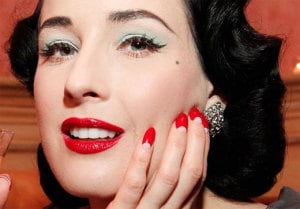 |
| Super last century. |
The half moon style that became popular is an interesting result of old social conventions, and new scientific superstitions colliding. You see, when ladies wore gloves all the time, one sign of a poor or uncultured woman was dirt under the fingernails from not wearing gloves and maybe even doing some *gasp* manual labour! There sprung up an idea that women who wore nail polish had something to hide – but the half moon manicure lands somewhere halfway between covering up your shameful working class nails, and going completely bare. You can still wear a pretty colour, while also demonstrating that you have the perfectly clean nails of a real lady.
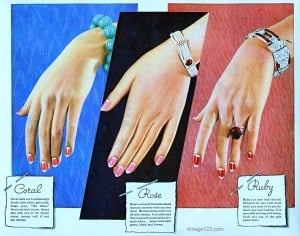 |
| Vintage123.com |
I would also guess that the notion that nails need to breathe started around this time too – while it’s patently untrue, it’s something a lot of people still believe today, so I can only imagine the idea was pretty compelling in the early decades of this century when science was still pretty mysterious to the general public. By leaving the moon of the nail, where it grows from the nail bed, and the tip bare, the nail could “breathe” under the colour.
Anyway, the whys and the hows aside, this is a really interesting manicure style, so I thought I would do up a little tutorial for you. This would be amazing to recreate for a flappers party!
You will need:
– A solid colour polish, preferably a nice dark vampy red for period accuracy. I used Illamasqua Scarab.
– Optional: a pale pink/nude polish. I used Loreal Color Riche in Rose Paradis.
– Masking tape, and some scissors.
1. Before you put anything on your nails, get out some masking tape, scissors, and something to stick your tape to once you’re done. Cut a strip of tape about the width of your nail, and then cut that a semi circle out of the tape. Stick the semi circle and the corresponding arch shape to your table, remote, whatever you’re using. Repeat until you have a pair of tape bits for each finger.
2. If you have nice, unstained nails, you can skip this part. Unfortunately I have a terrible weakness for blue polishes that have a horrible habit of staining, so when completely naked my nails look like this.
To remedy this and create a smooth, clean canvas for the rest of the manicure I put on a quick coat of a nude pink polish. I like to put a thin coat of quick dry top coat over the top of this, to help prevent the tape lifting the polish off later. Let this dry completely.
3. Carefully place the semi circle tape bit over the moon of your nail. Place the arch shape over the tip of your nail, and wrap it gently so it sticks nicely to the edges.
4. Using your main colour polish, paint the area between the two tape strips.
5. Carefully remove the tape with tweezers, being sure to take it off slowly and gently.
6. Cover the whole thing with your choice of topcoat.
And with that, you’re ready to party like it’s 1929!
Cassie can be found blogging at The Reluctant Femme, and occasionally elsewhere around the web (such as Lacquerheads of Oz). She’s a Twitter addict (@anwyn) and posts lots of square nail photos too.
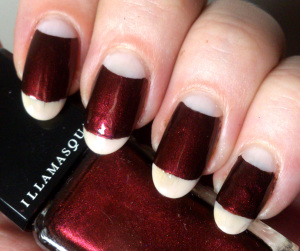
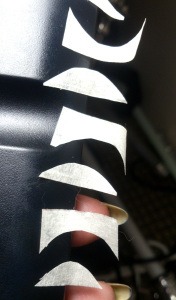
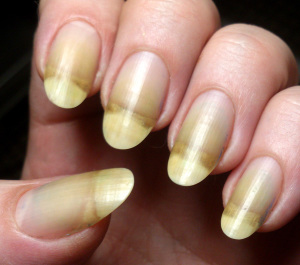





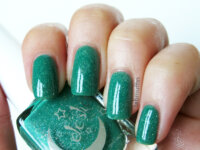
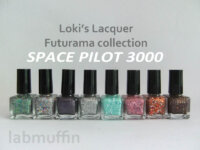
Thanks Cassandra. I love the method of painting nails from this era.
I knew the half-moon was from the 20s, but I did not know the reason why it developed instead of full colour nails. Thanks for the research!
I just asked this question the other day in a post, wondering if it was a real mani true to the times or a Baz Luhrmann inspired creation for Gatsby! Thanks for doing the research! 🙂
You’re most welcome 🙂 Researching random things is my jam.
this is really interesting! awesome little history lesson 🙂
Beautiful!!<3 xx Peach
http://momomoworld.blogspot.com
Fascinating! I enjoyed the history lesson and plan to try this nail tutorial soon 🙂
Also, early nail lacquers were extremely prone to chipping. Keeping the polish away from the tip of the nail was a good way to extend the life of your manicure. There are still ladies I know who practice this mani.